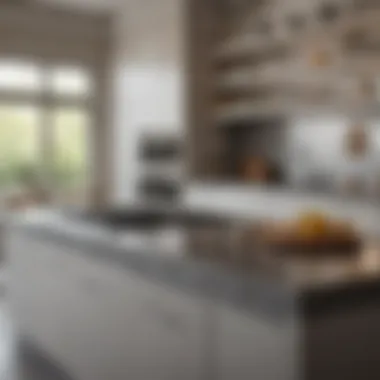The Significance of Immaculate Housekeeping in Homes


Intro
Clean housekeeping is more than just a chore. It forms the backbone of an impressive home. A well-maintained space communicates pride and respect for one's environment. It fosters a sense of calm and well-being. This article explores the significance of tidy living spaces. It aims to educate homeowners on various practical strategies for achieving cleanliness.
A clean home can enhance not only aesthetics but also functionality. The design of a space is often overshadowed by clutter, diminishing its true potential. By emphasizing the connection between cleanliness and design, we provide valuable insights. This guide resonates with both prospective homebuyers and seasoned homeowners.
Proper housekeeping practices can elevate any home, regardless of its architectural style or location. Understanding how to maintain cleanliness effectively can empower homeowners to appreciate their spaces more fully. The importance of this discipline will be unraveled throughout the article.
Understanding Clean Housekeeping
Clean housekeeping serves as the backbone of any exceptional home. A meticulous approach ensures not only aesthetic appeal but also a nurturing environment conducive to health, well-being, and functionality. It transcends mere tidiness; it embodies a lifestyle reflecting attention to both domestic and aesthetic aspects of living. Understanding clean housekeeping thus incorporates an exploration of its definition, relevance to everyday living, and the crucial differences between various terms associated with home maintenance.
Defining Housekeeping in Modern Context
Housekeeping in the contemporary context involves much more than simply doing chores. It encompasses a broad range of tasks and responsibilities that contribute to the overall maintenance and aesthetic appeal of a living space. Today’s homeowners often seek to integrate cleanliness with sustainability, efficiency, and comfort.
In this sense, housekeeping includes:
- Regular cleaning schedules: Systematizing tasks helps in maintaining order and cleanliness, ensuring no area of the home is neglected.
- Organization: This involves decluttering spaces and making them functional, prioritizing flow and ease of movement within each room.
- Aesthetic choices: Selecting materials, colors, and décor that not only beautify spaces but also are easy to clean and maintain is important.
Clean housekeeping promotes an environment that reflects sophistication and care, essential for enhancing a property's value and livability.
Housekeeping vs. House Cleaning
It is important to differentiate between housekeeping and house cleaning, as these terms are often confused. Housekeeping can be viewed as an overarching discipline that includes organizing, managing, and maintaining a household's daily needs versus house cleaning, which specifically refers to the act of cleaning various surfaces and areas in the home.
Some distinctions include:
- Scope of Work: Housekeeping covers a wide range of tasks—laundry, meal prep, and inventory management—while house cleaning primarily focuses on scrubbing surfaces and tidying up.
- Frequency: Housekeeping involves ongoing tasks that maintain order daily or weekly. House cleaning is often scheduled less frequently, perhaps weekly or monthly, depending on the household's needs.
- Skills Involved: While both require a certain skill set, housekeeping may include budgeting and planning, whereas house cleaning concentrates on technical cleaning techniques.
Understanding these differences helps homeowners prioritize tasks effectively, enhancing the overall hygiene and functionality of their homes.
"A clean environment is essential for creating a space that promotes health, tranquility, and success."
Consequently, acknowledging clean housekeeping as a practice is integral for cultivating a home that reflects integrity and beauty.
The Importance of Cleanliness
Cleanliness serves as a foundation for maintaining a thriving household. It creates an environment that fosters not only physical well-being but also mental clarity. In exceptional homes, cleanliness is not just about aesthetics. It reflects the residents’ values and impacts their quality of life. This section delves into how cleanliness molds physical health and psychological wellness, linking these dimensions integral to the domestic experience.
Impact on Physical Health
A clean living space significantly affects physical health. Regular upkeep helps to eliminate dust, allergens, and pathogens that can cause illnesses. For instance, environments that lack proper housekeeping can lead to respiratory issues and allergies. Dust mites, mold, and pet dander are common invaders in homes that do not receive thorough cleaning.
This routine of keeping surfaces sanitized contributes to the well-being of all residents. Properly cleaned areas minimize the spread of infections, especially critical in households with young children or elderly members. Additionally, clean spaces often encourage better habits, such as exercising at home or preparing healthier meals.
"A clean environment is a key element for thriving health and hygiene."
Consider implementing a structured cleaning regime that includes the following:
- Vacuuming carpets at least once a week to reduce dust accumulation.
- Wiping down surfaces with disinfectant cleaners regularly to kill germs.
- Maintaining airflow by ensuring proper ventilation, which helps eliminate pollutants.
Such practices create a healthier home where residents can live freely without the burden of preventable health issues.
Psychological Benefits of a Clean Environment
The psychological impacts of cleanliness are equally vital. A clean home contributes to reduced stress and increased productivity. In environments cluttered with items, mental clutter also prevails. Organizing and cleaning can open pathways to clearer thinking and better focus.
Studies have shown that individuals living in cleaner homes tend to exhibit higher levels of satisfaction and happiness. They experience lower anxiety levels through reduced visual distractions and a sense of order. Clean homes provide comfort, allowing dwellers to unwind and rejuvenate.
Implementing effective housekeeping strategies can enhance these mental benefits:
- Declutter regularly to create a more inviting space.
- Incorporate plants, which not only beautify but also purify the air and elevate mood.
- Use calming color schemes to promote relaxation and mental peace.
In summary, maintaining cleanliness is crucial in homes. It intertwines health with psychological well-being, underlining the importance of clean housekeeping in exceptional spaces.
Housekeeping Strategies for Different Homes
Effective housekeeping is not one-size-fits-all. Each type of home, whether it be an urban apartment, a suburban house, or a rural property, presents unique challenges and opportunities. Understanding these specifics allows homeowners to adopt tailored strategies that enhance not only aesthetics but also the overall functionality of their spaces. This section will explore key strategies that cater to different housing environments, ensuring the cleaning process respects the distinctive needs of each setting.
Urban Apartments
Urban apartments often present space limitations, making efficient management essential. Homeowners can maximize compact living through practical techniques that conserve the available area while maintaining a clean environment.
Space-Saving Techniques
Space-saving techniques ensure that every square foot is utilized effectively. Utilizing multifunctional furniture is a prime example. For instance, beds with drawers or ottomans that double as storage can hold belongings without adding clutter. This is particularly beneficial for urban dwellers who may struggle against cramped quarters.
Key characteristics of space-saving techniques include:


- Maximizing available storage: Fittingly designed shelves or under-bed storage make a significant difference in organization.
- Aesthetic appeal: Well-organized spaces contribute to a visually pleasing environment, essential for high-value areas in homes.
Advantages include increased storage and maintenance ease, while the potential disadvantage is the initial investment in quality furniture.
Utilizing Vertical Space
Utilizing vertical space is another important strategy in urban settings. It involves making use of wall areas by adding shelves or hooks. This approach helps declutter surfaces and creates a perceived sense of height, making rooms appear more spacious.
Essentially:
- Integrates style with functionality: Vertical installations can be both practical and attractive.
- Encourages organization: Everything from books to plants can be displayed neatly upwards, saving floor room.
This method can enhance a home’s visual dynamics, although it may require certain wall considerations, such as weight limits or damage to surfaces.
Suburban Homes
Suburban homes typically provide more space than their urban counterparts. This advantage allows for maintenance strategies that emphasize regular upkeep and outdoor cleanliness.
Routine Maintenance Schedules
Implementing routine maintenance schedules is crucial in suburban homes. Regular checks and balances assist in identifying issues before they escalate. For example, inspecting gutters and drains can prevent water damage later on.
Key aspects involve:
- Consistent care: Scheduling tasks like vacuuming, mopping, or gardening at specific intervals promotes ongoing cleanliness.
- Seasonally critical: Certain tasks will relate to seasonal changes, like clearing leaves in fall or prepping gardens in spring.
The major benefit is preventative maintenance, while the disadvantage may be the setup of a planned schedule that some may find difficult to adhere to due to busy lifestyles.
Outdoor Cleanliness Practices
Suburban properties often include outdoor spaces, which require their own set of housekeeping practices. Maintaining patios, lawns, and driveways is essential for both aesthetic and functional reasons. Regular lawn care and debris removal contribute to overall curb appeal.
Notable points include:
- Enhancement of property value: Neat exteriors reflect positively on overall home valuation.
- Environmental benefit: Well-kept gardens can improve local ecology while providing personal outdoor enjoyment.
The main consideration here is the time commitment involved in outdoor care, which may deter some homeowners.
Rural Properties
Rural properties tend to integrate natural environments in unique ways. Housekeeping strategies in these areas must accommodate both indoor and outdoor spaces intricately linked to nature.
Seasonal Cleaning Tasks
Seasonal cleaning tasks address the impact of changing weather conditions on rural homes. For example, preparing for snow can involve installing weatherproofing solutions while ensuring heating systems are functional.
Key points to note:
- Adapts to natural cycles: Spring cleaning traditionally includes equipment for outdoor chores or managing organic material buildup.
- Improves livability: Seasonal tasks enhance comfort throughout the year by managing potential hazards like mold or pests.
Advantages include thorough readiness for seasonal changes, though the disadvantage is the labor intensity often required for larger properties.
Managing Natural Elements
Managing natural elements is an essential aspect of rural housekeeping. Homes here often face challenges such as increases in pests or wear from local wildlife. Effective management strategies can reduce these impacts.
Key characteristics:
- Protective measures: Utilizing screens for windows and natural repellents can limit pest invasions while respecting the local environment.
- Sustainability focus: Adopting green practices enhances both efficiency and environmental harmony.
The complexity of managing these elements can sometimes appear daunting, especially for new homeowners. However, with proper strategies in place, the benefits often outshine the challenges.
The Relationship Between Design and Cleanliness
Cleanliness is not merely an aesthetic choice; it is integral to the broader narrative of architectural design. An interplay exists between how a space is designed and how its cleanliness is maintained. When a home is designed with cleanliness in mind, it enhances its livability, beauty, and overall experience. This connection between design and cleanliness plays a critical role in any exceptional home. Well-maintained surfaces increase the appreciation of architectural details, while the functionality of spaces designed for easy cleaning contributes to the comfort of the inhabitants.
How Cleanliness Enhances Architectural Design
Clean spaces allow the architecture of a home to shine. When surfaces are clean, they highlight features such as lines, textures, and forms that may otherwise go unnoticed. Moreover, cleanliness adds a sense of order and organization which can amplify the intended design aesthetic. Imagine a sleek modern kitchen with polished countertops and gleaming appliances; the clarity of these elements becomes visually impactful when they are not cluttered by dirt or debris.
Additionally, a clean environment can evoke a sense of tranquility. This is especially true in open concept designs that often blend living spaces. In these environments, the clarity of space becomes a hallmark of good design. Therefore, one can argue that cleanliness embodies an essential aspect of design philosophy that prioritizes functionality and beauty in harmony.
Choosing Designs That Favor Cleanliness
Designing a home with cleanliness in mind can inform numerous decisions, from material choices to color schemes. Making deliberate choices in these areas not only supports easier maintenance but also enhances the aesthetic appeal of the home.
Material Selection
Material selection is critical in design, as these choices directly influence the ease of upkeep. Certain materials resist stains and are easier to clean, which means less time and effort wasted on maintenance. For example, quartz countertops have gained popularity due to their durable nature and resistance to bacteria. This makes them both practical and aesthetically pleasing.
A key characteristic of materials like ceramic tiles or stainless steel is their ability to remain clean with minimal effort. These materials can withstand heavy use while maintaining their appearance over time. However, some materials, such as untreated wood or delicate fabrics, can require more care and attention to remain clean.


Ultimately, selecting materials that favor ease of cleaning supports the overarching goal of a well-maintained home. In this sense, the benefits of smart material choices shine clearly.
Color Schemes
Color schemes play an important role in how cleanliness is perceived in a space. Light colors, such as whites and pastels, can make rooms appear brighter and larger, enhancing the feeling of cleanliness. On the other hand, darker colors can hide dirt but may also hide the details of architectural features.
A popular choice is to use neutral tones as bases, accentuated with pops of color. This approach creates a welcoming atmosphere and maintains visual interest while allowing for easier identification of areas that might need cleaning. Unique features of color schemes centered around cleanliness often include their adaptability to various styles, making them versatile choices across different spaces.
Practical Housekeeping Techniques
Practical housekeeping techniques play a vital role in ensuring a clean and organized living space. These methods not only promote hygiene but also contribute to the overall aesthetic appeal of a home. Effective housekeeping routines can significantly enhance the functionality of various spaces, making them more pleasant and easier to navigate. Each technique serves a purpose and has specific benefits that align with maintaining an exceptional home.
Daily Housekeeping Routines
Daily housekeeping routines are essential for maintaining order and cleanliness in a home. These routines encompass tasks that need attention every day, such as washing dishes, making beds, and wiping surfaces. Engaging in these tasks regularly prevents dirt accumulation and minimizes stress related to cleaning. When daily chores become a habit, they contribute to a more pleasant living environment.
Incorporating organization into a daily routine is critical. For instance, putting items back in their designated places after use can drastically reduce clutter. Additionally, setting aside a few minutes each day for light cleaning tasks can ensure that the home remains welcoming.
Weekly and Monthly Cleaning Tasks
Maintaining a clean home goes beyond daily chores. Weekly and monthly cleaning tasks are necessary to manage deep-set dirt and prepare for higher traffic times. These tasks might include vacuuming, dusting, mopping, and other activities that require more time or resources.
Decluttering Strategies
Decluttering strategies are a fundamental aspect of effective housekeeping. This process helps to clear unnecessary items from a space, making it feel larger and more functional. A key characteristic of decluttering strategies is their adaptability; they can be tailored to fit different lifestyles and preferences.
A popular choice among homeowners is the "one in, one out" rule. This strategy encourages individuals to remove an item whenever a new one is added. By maintaining a balance, homeowners can prevent clutter accumulation. Its unique feature lies in promoting conscious consumerism, which blends well with sustainable living. However, it requires discipline and commitment to maintain a clutter-free environment.
Deep Cleaning Essentials
Deep cleaning essentials are specific tasks that require more attention and thoroughness compared to everyday cleaning. This may include tasks like cleaning oven interiors or scrubbing bathroom tiles. This aspect of housekeeping contributes significantly to a home's overall cleanliness and health by targeting areas that often go neglected.
A key characteristic of deep cleaning is its ability to eradicate allergens and buildup that may impact indoor air quality. While deep cleaning is a beneficial practice for ensuring a hygienic environment, it also requires planning and time. Some homeowners may find it daunting due to the effort involved, but establishing a deep cleaning schedule can make the process more manageable.
"A clean home is a reflection of a well-organized mind."
Technology and Housekeeping
In contemporary homes, the intersection of technology and housekeeping has become increasingly vital. Modern innovations are reshaping how we maintain cleanliness and order within our living spaces. These advancements not only enhance efficiency but also contribute positively to the overall ease of housekeeping tasks. The integration of smart devices and innovative cleaning tools simplifies this essential aspect of home management, accommodating various lifestyles and preferences.
Smart Home Interfaces
Smart home interfaces have revolutionized the way we interact with our home environments. These systems allow homeowners to control various functions remotely, creating a more streamlined approach to housekeeping. Users can manage schedules for cleaning, adjust environmental settings, and monitor home cleanliness through a central hub. Additionally, these systems often can be integrated with existing smart devices for enhanced functionality. The convenience of controlling everything from lighting to vacuum schedules through voice commands or a mobile app makes it an attractive option for modern households. Its adaptability to specific household needs adds to its appeal, creating a personalized space that promotes cleanliness effortlessly.
Innovative Cleaning Tools
Robotic Vacuums
Robotic vacuums are a significant advancement in cleaning technology. Their design allows them to navigate various floor types and obstacles autonomously. This feature is crucial for homeowners who seek to maintain a clean environment with minimal effort. One key characteristic of robotic vacuums is their scheduling capabilities; users can set them to clean at specific times, ensuring that dust and debris are regularly managed.
However, while these devices provide numerous benefits, they are not without limitations. For instance, their effectiveness can diminish on high-pile carpets or in cluttered spaces. Nevertheless, their ability to perform routine cleaning tasks makes them a popular choice in the pursuit of maintaining a clean living environment.
Automated Systems
Automated systems represent another innovative approach to enhancing housekeeping. These systems offer a range of functionalities, from automated lighting to advanced cleaning schedules that can be customized to each home's needs. One of the key features of automated systems is their capacity to learn user preferences over time, allowing for adjustments that reflect the household's habits.
The benefits of such systems lie in their ability to deliver consistent results with little manual intervention. On the downside, the initial setup and potential compatibility issues with existing devices can pose challenges. Despite these drawbacks, automated systems serve as effective tools that facilitate a higher standard of cleanliness through technology-driven solutions.
"Technology in housekeeping is not just about tools. It's about creating a smart living environment that aligns with modern lifestyles."
In summary, the advancement of technology in housekeeping offers distinct benefits that make maintaining a clean home more achievable. From smart home interfaces providing remote control to innovative cleaning tools like robotic vacuums and automated systems, these technologies underscore the importance of integrating modern solutions into everyday life.
Sustainability in Housekeeping
Sustainability in housekeeping is a crucial theme in maintaining modern homes. It reflects an awareness of our environmental responsibilities while also ensuring homes remain functional and aesthetically pleasing. Integrating sustainable methods into housekeeping routines can lead to numerous benefits. These range from minimizing waste and conserving resources to preserving local ecosystems. Homeowners now recognize the significance of sustainability in their daily routines and long-term strategies for keeping their homes clean.
Eco-Friendly Cleaning Products
Using eco-friendly cleaning products is essential in sustainable housekeeping. These products typically consist of natural ingredients that are safer for both the environment and the health of occupants. Unlike conventional cleaners loaded with harsh chemicals, eco-friendly alternatives reduce indoor air pollution and lower the risk of allergic reactions or respiratory issues.
Many homeowners are now opting for brands like Seventh Generation and Mrs. Meyers, which focus on plant-based ingredients and biodegradable packaging. Furthermore, many of these products are effective against germs and dirt without compromising on safety. Their growing popularity highlights an important shift in consumer preferences towards more environmentally-conscious choices.
Energy-Efficient Practices
Energy-efficient practices are another vital component of sustainable housekeeping. They contribute towards lowering household expenses while also helping to reduce the environmental footprint. Adopting energy-efficient appliances and methods not only streamlines cleaning tasks but also lessens energy consumption. Here are two key practices that demonstrate a commitment to energy efficiency in housekeeping:
Water Conservation Techniques
Water conservation techniques play a significant role in sustainable housekeeping. This aspect focuses on minimizing water use, which is increasingly important given global water scarcity. Techniques can include using water-efficient appliances like dishwashers and washing machines, which consume less water compared to traditional models.


By being mindful of how much water is used during cleaning, homeowners can save money and resources. For example, rinsing vegetables or using a basin for washing instead of running water continuously are effective strategies. Many find that implementing water conservation techniques is not only beneficial for the environment but also encourages a more thoughtful approach to overall water use at home.
Reducing Waste
Reducing waste is another essential aspect of sustainable housekeeping. This approach emphasizes minimizing trash output by rethinking cleaning routines and product choices. Homeowners can adopt practices like using reusable cleaning cloths instead of disposable wipes, which helps dramatically cut down on household waste.
Additionally, embracing bulk purchasing and minimizing product packaging also contribute to waste reduction. Families are becoming more aware of the negative impact of excessive waste, leading to an increase in community initiatives focused on recycling and composting. While transitioning to a waste-reduction lifestyle can require adjustments, the long-term benefits greatly outweigh the initial challenges.
"Sustainable housekeeping is not just a trend; it has become an essential commitment to balancing home maintenance with environmental stewardship."
Cultural Perspectives on Cleanliness
Understanding the cultural perspectives on cleanliness is fundamental when exploring the significance of housekeeping. Various cultures have distinct attitudes towards cleanliness and order, shaping the way individuals approach and maintain their living spaces. This understanding can enhance our appreciation for different housekeeping practices and their impact on our environments. The beauty of a home is not solely in its architecture or design but also in the care and attention applied in keeping it clean.
Examining global housekeeping practices reveals the diversity in methods and values surrounding cleanliness. For instance, many Asian cultures place a strong emphasis on cleanliness as a reflection of personal discipline and respect for the home. Cleaning rituals are often integrated into daily life, transforming them from mere chores into significant cultural practices. In contrast, some Western cultures may prioritize convenience, leading to a reliance on modern cleaning innovations and automation.
Global Housekeeping Practices
Housekeeping practices vary significantly across regions and cultures, each with its unique elements:
- Japanese Practices: In Japan, the practice of cleaning, known as souji, is deeply rooted in the philosophy of mindfulness. It emphasizes tidiness and the notion of "cleaning as a meditation."
- Nordic Approaches: Scandinavian countries often incorporate minimalistic designs that prioritize functionality and ease of cleaning, promoting fewer possessions and a focus on what truly matters.
- Middle Eastern Traditions: In many Middle Eastern cultures, cleanliness is seen as both a physical and spiritual necessity, deeply tied to religious practices. Homes are often cleaned and prepared for guests to reflect hospitality.
These various practices highlight the unique ways that different cultures approach the concept of cleanliness within the home, influencing how people care for their spaces and how they interact with their environments.
The Role of Cleanliness in Different Cultures
Cleanliness plays an important role in many cultures, often viewed as a virtue indicating social status, health, and moral integrity.
In Hindu culture, regular household cleaning is seen as a duty, essential for inviting positive energy into the home. The act of cleaning before festivals is not just about tidiness, but also about spiritual preparation.
In Islam, cleanliness holds substantial religious significance. The concept of tahara is essential within the faith, and maintaining a clean home is celebrated as both a practical and spiritual endeavor.
- Western Cultures: In many Western societies, cleanliness is equated with modernity and sophistication. Consumerism often drives the purchasing of products that promise easier cleaning solutions, showing a sometimes transactional view towards housekeeping.
In summary, cultural perspectives on cleanliness shape the practices, values, and tools employed in housekeeping. Acknowledging these differences offers valuable insight into our personal and collective approaches to home care, fostering understanding and appreciation for various customs across the globe.
Housekeeping Resources and Tools
Housekeeping is an essential practice for maintaining an exceptional home. This importance is reinforced by the array of resources and tools available to assist homeowners in their pursuit of cleanliness and order. Understanding these resources can significantly enhance the effectiveness of housekeeping efforts. The right tools not only streamline the cleaning process but also offer valuable insights and training on best practices.
Books and Guides
Books and guides are invaluable resources for anyone seeking to improve their housekeeping skills. They cover a wide range of topics, from basic cleaning techniques to advanced methodologies on home organization. Many guides also address specific challenges based on different types of homes—urban apartments, suburban houses, and rural properties.
For instance, some books delve into the psychology of cleanliness, explaining how maintaining a tidy space impacts mental well-being. Others offer practical tips on using eco-friendly cleaning products, which aligns with sustainable living practices. Homeowners should look for books that not only provide cleaning tips but also inspire a deeper understanding of the significance of a clean environment.
Here are some notable aspects of utilizing books and guides for effective housekeeping:
- Diverse Techniques: Ranging from daily routines to seasonal deep cleaning.
- Cultural Insights: Some materials offer a glimpse into global housekeeping practices.
- Illustrative Examples: Step-by-step guides often include photographs, demonstrating effective strategies visually.
Online Resources and Communities
The internet has transformed how we access information about housekeeping. Online blogs, forums, and social media platforms are rich with content on housekeeping tips and tricks, catering to all levels of expertise. Engaging with these communities allows individuals to share experiences, seek advice, and discover innovative solutions to common problems.
Platforms like Reddit host numerous threads where users discuss their favorite cleaning hacks, recommend products, and share personal stories about their housekeeping journeys. This interaction fosters a sense of community among those who prioritize cleanliness.
Here are important features of online resources and communities in housekeeping:
- Real-Time Updates: Access the latest trends and tips instantly.
- Diverse Perspectives: Learn from a variety of experiences from people across the globe.
- Interactive Learning: Engage in discussions that clarify doubts and offer fresh ideas.
Future Trends in Housekeeping
The evolution of housekeeping practices reflects changes in technology, society, and culture. As we explore the future trends in housekeeping, it is vital to understand how these trends contribute to the overall maintenance and beauty of homes. Clean housekeeping is not merely a chore; it is an essential aspect of home management that maintains hygiene, safety, and aesthetics. The integration of modern tools and approaches can significantly enhance these qualities.
Emerging Cleaning Technologies
One cannot overlook the impact of technology on housekeeping. Advances in cleaning systems and products streamline tasks and improve results. For instance, innovations like robotic vacuums have transformed ordinary cleaning routines. These devices allow for hands-free maintenance of floors, which is particularly beneficial in busy households.
Smart home technology also plays a large role. Systems that connect cleaning tools with mobile apps present a level of control that was unimaginable a decade ago. Homeowners can schedule cleanings, receive alerts, and manage tasks remotely. This reliance on technology not only saves time but also promotes consistency. As we become more integrated with our devices, the demand for user-friendly technology will likely define the future of clean housekeeping.
Key technologies may include:
- AI-driven cleaning devices: Machines that learn from their environment to improve efficiency.
- Eco-friendly cleaning solutions: Products that meet both cleaning standards and environmental concerns.
- Connected appliances: Items that integrate with home networks to allow remote management.
"The future of housekeeping is not just about cleanliness; it's about creating an environment where technology enhances our daily lives."
Evolution of Housekeeping Roles
As technology advances, the role of housekeepers also changes. Traditional views of housekeeping focused solely on manual tasks. However, as homes become more automated, the nature of these roles is evolving. Housekeepers may find themselves taking on more managerial responsibilities, focusing on optimizing cleaning routines with technology rather than performing repetitive tasks manually.
In the context of affluent homes, the expectations of housekeeping staff also shift. The demand for specialized training in the use of advanced cleaning technologies is rising. Professionals may need to understand how to operate robotic systems or choose appropriate eco-friendly products.
Housekeeping roles now may also include:
- Data Analysis: Understanding cleaning patterns and creating reports on efficiency.
- Facility Management: Overseeing entire home systems to ensure all aspects function together seamlessly.
- Client Interaction: Communicating needs and managing expectations among homeowners.
The evolution of these roles indicates a growing appreciation for skilled professionals who can adapt to emerging properties and lifestyles.
Collectively, the future trends in housekeeping reveal a direction towards greater efficiency, sustainability, and professionalism. Embracing these changes not only enhances the quality of home maintenance but also contributes significantly to the satisfaction of homeowners.















